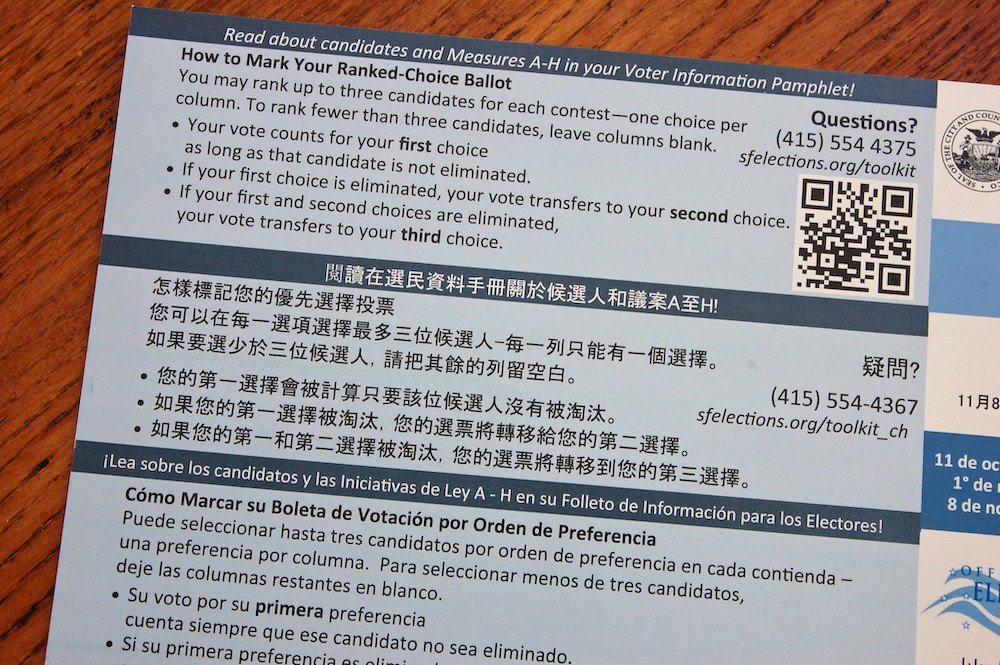If you’re thinking, “Oh my god, how is this election still happening?” just know that it doesn’t have to be this way.
By H Kapp-Klote
Here’s what ranked-choice voting instructions look like in San Francisco. (Photo: Flickr/janinsanfran)
A version of this article was first published in the Documenters Newswire newsletter on March 10, 2023.
You’ve probably heard by now that Mayor Lori Lightfoot lost her reelection campaign, the first time an incumbent Chicago mayor was not reelected in over 40 years. But that doesn’t mean that the race is over. We have a runoff system in Chicago (defined in last Friday’s issue), which means any race where a candidate doesn’t receive more than 50% of the vote triggers a second tiebreaker election.
With a nine-way mayoral race, it’s no surprise that no candidate scored more than 50% of the vote. So, the two candidates with the most votes, Paul Vallas and Brandon Johnson, will now advance to a runoff on April 4 (as will aldermanic candidates in 12 wards). This runoff means more work for candidates and voters alike. Vallas and Johnson will continue handshaking, fundraising and scrambling for endorsements well into the spring. People who initially voted for one of the other seven candidates will now have to choose between Vallas and Johnson.
Chicago’s whole runoff process is time-consuming and expensive. It’s also rife with voter fatigue, the technical term for feeling like “oh my god, how is this election still happening?” So as our 2023 election saga continues, it’s worth considering: Do Chicago elections really need to be this hard?
Alder Matt Martin (47th Ward) doesn’t think so. That’s why he recently introduced an ordinance that calls on City Council to consider replacing the runoffs with ranked-choice voting, a system that could make Chicago’s elections faster, smarter and more fair.
WHAT IS RANKED-CHOICE VOTING?
Ranked-choice voting, or instant-runoff elections, means that voters rank the candidates running for office by preference in a single round of voting, from the one they think is best for the role to the one they think is the worst. Your vote is cast for the candidate at the top of your list, but in the event that no candidate is 50% of voters’ top choice outright, the ranked-choice ballot has collected enough information that we can do the math instead of throwing another election.
What follows is a series of elimination rounds; the candidate with the fewest votes is eliminated and votes initially cast for them go to the candidate who was #2 on each voter's list. This continues until one candidate has enough votes to win. You can see a comprehensive visual calculator of how this could have worked in Chicago’s mayoral election, made by Reform for Illinois, here.
Cities like Minneapolis, San Francisco, New York, Boston and Chicago’s north-suburban-neighbor Evanston all use (or will soon begin using) a ranked-choice voting system for their elections. The number of cities and states moving to this system is growing, as 62 jurisdictions across the country have adopted ranked-choice voting in the last few years.
COULD RANKED CHOICE VOTING WORK FOR CHICAGO?
Ranked-choice voting would be a much better approach to Chicago’s crowded, lengthy and expensive nonpartisan elections, Will Mandell of FairVote, a national ranked-choice voting advocacy group, told me.
For one, it would minimize financial and logistical hurdles for election boards, candidates and voters. FairVote estimates that adopting ranked-choice voting could save the Chicago Board of Elections up to $3 million in an election year. The streamlined process would also level the field for candidates who may not have the deep pockets or political insider connections to compete with their opponents.
For voters, the ranked-choice method may be initially confusing, but an overwhelming majority of respondents to an exit poll during New York City’s last election found the new ranked-choice voting process easy. It’s also designed to alleviate other pressures, like voter fatigue, that make for low turnout. In spite of high early-voting rates in Chicago, the number of votes cast on Election Day were significantly lower than expected, particularly in majority-Black wards. (Overall turnout was still higher than in 2019.) By making voting easier and accessible, and sticking with a single election to name a winner, ranked-choice voting could help get more people to the polls. It would also reduce strategic voting, where voters try to determine each candidate’s chance of making it to the runoff Game of Thrones style, instead of backing the candidate they feel would be best for the job.
But not everyone is a fan of ranked-choice voting. There are concerns about the initial cost of ranked-choice voting, which requires new processes and software (though a study at the MIT Election Lab found that these costs weren’t statistically significant). And a recent ranked-choice election in Alaska had some worrying that it could exacerbate political polarization, rewarding extremist candidates over those who seek a middle ground. (Politifact has a great analysis of Sen. Tom Cotton’s comments on this race and why they are misleading.)
Alder Martin’s ordinance got routed to City Council’s Rules Committee, which is often a tactic to stall unpopular proposals, but he remains hopeful about changing how Chicago votes — before we start the process all over again in 2027.
Update (March 20, 2023): This post has been edited to clarify that Evanston has not yet implemented ranked-choice voting, as well as adding an attribution for the ranked choice visual calculator.
H Kapp-Klote is a writer, digital strategist, Documenter and City Bureau fellowship alum.
Subscribe to the Documenters Newswire, a twice-weekly newsletter for Chicagoans looking to make a difference in their communities.
This story is available to republish under a Creative Commons license. Read City Bureau’s guidelines here.
Support City Bureau’s community-centered reporting by becoming a City Bureau sustaining donor today.

